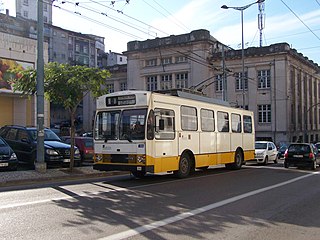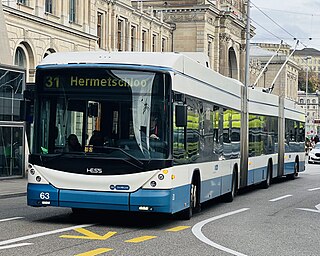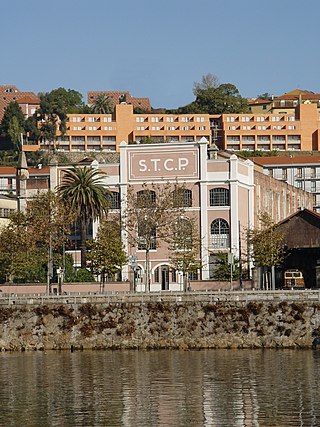
Heritage streetcars or heritage trams are a part of the efforts to preserve rail transit heritage. In addition to preserving street-running rail vehicles, heritage streetcar operations can include upkeep of historic rail infrastructure. Working heritage streetcars are closely related to the growing global heritage railway movement and form a part of the living history of rail transport.

Geneva Public Transport operates most of the public transportation system in canton of Geneva, Switzerland, including the city of Geneva. The agency's head office is in Grand-Lancy, Lancy.

The Porto Metro is a light rail network in Porto, Portugal and a key part of the city's public transport system. Having a semi-metro alignment, it runs underground in central Porto and above ground into the city's suburbs while using low-floor tram vehicles. The first parts of the system have been in operation since 2002. It is a separate system to Porto's vintage trams.

Guided Light Transit was the name of guided bus technology and associated infrastructure manufactured by Bombardier Transportation. Two GLT prototypes were designed and tested from 1987 onwards by BN in the region of Rochefort in Belgium. It was eventully installed in two French cities: Nancy and Caen. The Caen system was closed in 2017 and replaced by conventional trams, while the Nancy system was closed in March 2023 and is to be replaced by trolleybuses.
The Guindais Funicular is a funicular railway in the Portuguese city of Porto. It connects the Praça da Batalha, situated uphill to the north, with Cais dos Guindais, by the riverside to the south. The upper station is by the terminus of the vintage tram line 22 and within walking distance of São Bento station for metro and railway connections. The lower station is by the lower level of the Dom Luís I Bridge and within walking distance of the Praça da Ribeira.

Metro Tasmania, commonly called Metro, a Tasmanian Government business enterprise, is the largest bus operator in the state of Tasmania, Australia, with operations in three of the four largest urban centres of Hobart, Launceston, and Burnie. Urban services in Devonport are provided by a private operator, Kinetic. Services are provided by Metro under a range of urban and non-urban contracts with the Transport Commission, a division within the Department of State Growth.

The Glasgow trolleybus system operated in and immediately surrounding the city of Glasgow, Scotland, between 1949 and 1967, with the network reaching its largest extent in 1959. It was the only British system to open after World War II.

Servicio de Transportes Eléctricos de la Ciudad de México (STE) is a public transport agency responsible for the operation of all trolleybus and light rail services in Mexico City. As its name implies, its routes use only electrically powered vehicles. It was created on 31 December 1946 and is owned by the Mexico City government. STE is overseen by a broader local governmental authority, Secretaria de Movilidad de la Ciudad de México (SEMOVI)(Secretariat of Mobility of Mexico City), formerly (SETRAVI) which also regulates the city's other public transport authorities, including Sistema de Transporte Colectivo, Red de Transporte de Pasajeros del Distrito Federal and Metrobús, as well as other forms of transportation in the district. STE's passenger vehicle fleet consists exclusively of trolleybuses, light rail, and aerial lift vehicles, and in 2007 its network carried 88 million passengers, of which 67 million were on trolleybus services and 21 million on light rail.

The tram system of Porto in Portugal is operated by the Sociedade de Transportes Colectivos do Porto (STCP) and currently has three regular tram routes with 30-minute headways. All are heritage tram routes, as they use vintage tramcars exclusively, and should not be confused with the modern Porto Metro light rail system.
Southend-on-Sea Corporation Transport was the overarching name given to the local municipal transport services provided to the town of Southend-on-Sea by the local council. Initially started as a tramway, although known officially as Southend-on-Sea Corporation Light Railway, the trams started operating on 19 July 1901 until the service was terminated on 8 April 1942. A trolleybus system was introduced in 16 October 1925, gradually replacing the tramway, before it closed on 28 October 1954. Motorbuses were first run by the Corporation in 1914, but two years later they withdrew the services. Buses did not return to the Corporation's service until 1932, eventually replacing the trams and trolleybuses. In 1974, the organisation was renamed Southend Transport, and after the Transport Act of 1985, it became involved in a bus war with rival Thamesway. The council sold Southend Transport to British Bus group in June 1993, which in turn was taken over by the Cowie group. Cowie was renamed Arriva in August 1998, with Southend Transport becoming Arriva serving Southend.

The Santos trolleybus system forms part of the public transport network in Santos, a municipality in the state of São Paulo, Brazil. Opened on 12 August 1963, it presently comprises only one line, and, along with the two São Paulo metropolitan area trolleybus systems, is one of only three trolleybus systems still operating in Brazil.

The Coimbra trolleybus system formed part of the public transport network in the city of Coimbra, Portugal. Opened in 1947, it supplemented, and then eventually replaced, the Coimbra tramway network. Service was suspended in March 2021 because of road construction, and officials stated that the suspension was temporary, but in late 2022 the mayor indicated that any resumption of trolleybus service would not occur until after completion of construction of a new Bus Rapid Transit line, around late 2024. However, in July 2024, the city council voted not to resume service – to make the suspension a permanent closure – albeit with a proposal floated for a future tourist trolleybus operation along the banks of the Mondego River, without further detail given.

Trams in Portugal have generally been traditional electric cars in large cities such as Lisbon, Porto and Sintra. Portuguese tram routes are typically, but not necessarily, tourist attractions.
Azienda Napoletana Mobilità SpA, more commonly known simply as ANM, is a municipally controlled public company that is the primary provider of urban public transportation in the city of Naples, Italy, and also provides a portion of the surface transit service in surrounding municipalities. In addition to a network of tram, trolleybus and motorbus routes, ANM operates the Naples Metro system and four urban funiculars. The metro system and funiculars were operated by a different company from 2001 to 2013, when they again became part of ANM.

The Neuchâtel trolleybus system is part of the public transport network in Neuchâtel, Switzerland. Opened in 1940, it gradually replaced the urban lines of the Neuchâtel tramway network.

The Zurich trolleybus system is part of the public transport network of Zurich, Switzerland. Opened in 1939, it combines the Zurich S-Bahn, the Zurich tramway network and Zurich's urban motorbus network to form an integrated all-four style scheme.
As of 2012 there were around 300 cities or metropolitan areas where trolleybuses were operated, and more than 500 additional trolleybus systems have existed in the past. For complete lists of trolleybus systems by location, with dates of opening and closure, see List of trolleybus systems and the related lists indexed there.

Transports publics de la région lausannoise, often abbreviated simply to tl, are the main operator of public transport in Lausanne and the wider agglomeration. As of 2012, TL operates a network of 10 trolleybus routes, 25 conventional bus routes and two métro lines, using more than 290 vehicles. TL operates weekend night services and demand responsive transport.
Public transport in New Plymouth is undergoing a revival after many years of minimal council support since the early 1990s. The system covers New Plymouth city, as well as services to Waitara, Inglewood, Ōakura and recently Stratford. Major changes were introduced on 31 May 2010. New routes were introduced, and service levels greatly expanded. Funding for the expanded service was provided on a “trial” basis for two years and was subject to the services performing satisfactorily. These services became permanent in 2012.

The Porto Tram Museum(Museu do Carro Eléctrico) is a museum operated by the Sociedade de Transportes Colectivos do Porto. It was inaugurated in 1992 and is installed in a former thermoelectric power station next to the River Douro in Massarelos, Porto, Portugal. It exhibits material related to the history of trams in Porto. The collection contains 16 electric cars, 5 trailers, and two maintenance vehicles as well as the former equipment of the power plant, which provided electricity for the tram lines.

















